Analysis of TV, advertising and other behavioral determinants of
Anuncio
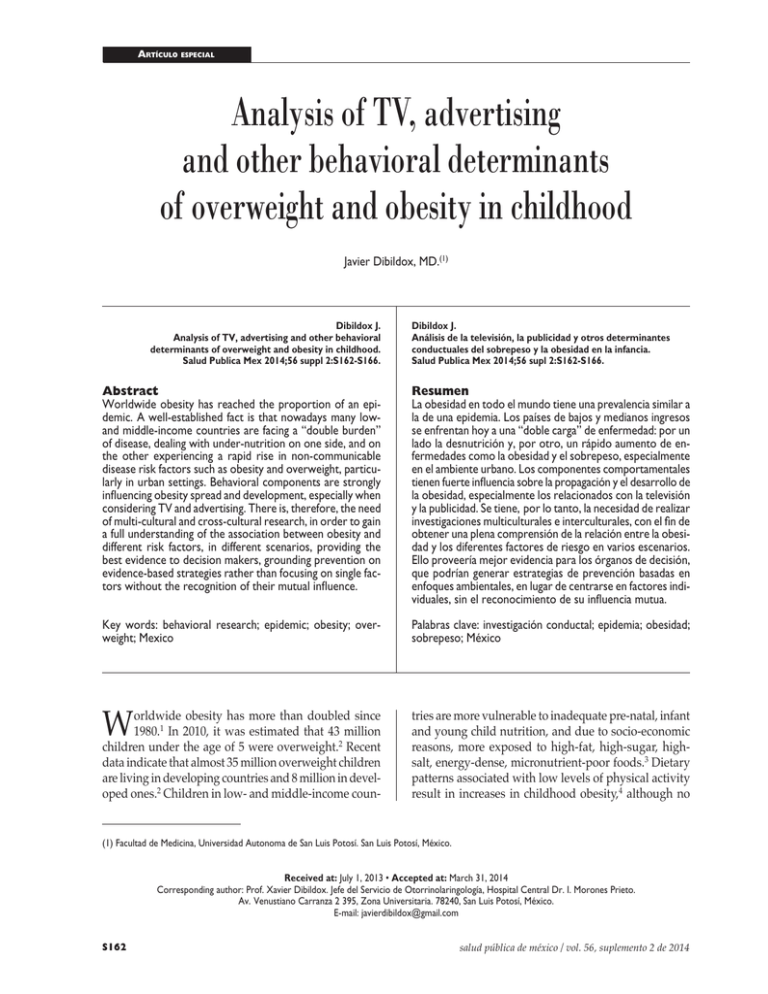
Dibildox J Artículo especial Analysis of TV, advertising and other behavioral determinants of overweight and obesity in childhood Javier Dibildox, MD.(1) Dibildox J. Analysis of TV, advertising and other behavioral determinants of overweight and obesity in childhood. Salud Publica Mex 2014;56 suppl 2:S162-S166. Dibildox J. Análisis de la televisión, la publicidad y otros determinantes conductuales del sobrepeso y la obesidad en la infancia. Salud Publica Mex 2014;56 supl 2:S162-S166. Abstract Worldwide obesity has reached the proportion of an epidemic. A well-established fact is that nowadays many lowand middle-income countries are facing a “double burden” of disease, dealing with under-nutrition on one side, and on the other experiencing a rapid rise in non-communicable disease risk factors such as obesity and overweight, particularly in urban settings. Behavioral components are strongly influencing obesity spread and development, especially when considering TV and advertising. There is, therefore, the need of multi-cultural and cross-cultural research, in order to gain a full understanding of the association between obesity and different risk factors, in different scenarios, providing the best evidence to decision makers, grounding prevention on evidence-based strategies rather than focusing on single factors without the recognition of their mutual influence. Resumen La obesidad en todo el mundo tiene una prevalencia similar a la de una epidemia. Los países de bajos y medianos ingresos se enfrentan hoy a una “doble carga” de enfermedad: por un lado la desnutrición y, por otro, un rápido aumento de enfermedades como la obesidad y el sobrepeso, especialmente en el ambiente urbano. Los componentes comportamentales tienen fuerte influencia sobre la propagación y el desarrollo de la obesidad, especialmente los relacionados con la televisión y la publicidad. Se tiene, por lo tanto, la necesidad de realizar investigaciones multiculturales e interculturales, con el fin de obtener una plena comprensión de la relación entre la obesidad y los diferentes factores de riesgo en varios escenarios. Ello proveería mejor evidencia para los órganos de decisión, que podrían generar estrategias de prevención basadas en enfoques ambientales, en lugar de centrarse en factores individuales, sin el reconocimiento de su influencia mutua. Key words: behavioral research; epidemic; obesity; overweight; Mexico Palabras clave: investigación conductal; epidemia; obesidad; sobrepeso; México W orldwide obesity has more than doubled since 1980.1 In 2010, it was estimated that 43 million children under the age of 5 were overweight.2 Recent data indicate that almost 35 million overweight children are living in developing countries and 8 million in developed ones.2 Children in low- and middle-income coun- tries are more vulnerable to inadequate pre-natal, infant and young child nutrition, and due to socio-economic reasons, more exposed to high-fat, high-sugar, highsalt, energy-dense, micronutrient-poor foods.3 Dietary patterns associated with low levels of physical activity result in increases in childhood obesity,4 although no (1) Facultad de Medicina, Universidad Autonoma de San Luis Potosí. San Luis Potosí, México. Received at: July 1, 2013 • Accepted at: March 31, 2014 Corresponding author: Prof. Xavier Dibildox. Jefe del Servicio de Otorrinolaringología, Hospital Central Dr. I. Morones Prieto. Av. Venustiano Carranza 2 395, Zona Universitaria. 78240, San Luis Potosí, México. E-mail: [email protected] S162 salud pública de méxico / vol. 56, suplemento 2 de 2014 Behavioral determinants of overweight and obesity in children consensus has yet been reached on the association between energy balance and obesity.5 When considering diseases attributable to obesity and overweight, the analysis carried out in the World Health Report 2002 showed that 58% of diabetes, 21% of ischaemic heart disease, and 8-42% of certain cancers globally were attributable to a BMI above 21 kg/m2.6 In this epidemic scenario, research on obesity and overweigh determinants has been conducted worldwide,7-13 although conclusions on risk factors and needed actions do not appear homogeneous5,14-17 as exemplified by a Cochrane systematic review that included 22 randomized clinical trials that failed to show that diet and exercise, separately evaluated were effective in preventing weight gain in children,18 and the complex interplay of factors must not be overlooked when planning an intervention, especially when targeting children and adolescents. Discussion Genetic, culture, social environment forging behavioral determinants The specific definition of behavioral aspects related to excessive or inadequate energy intake is a task that has been broadly undertaken, with diverse outcomes. On a daily basis it is not possible to quantify energy intake and expenditure at an individual level with sufficient accuracy to infer which aspects of these two processes are responsible for the rise in the prevalence of childhood obesity.19 Food choices are modulated from different interactive agents.20 Biology and physiology (hunger, thirst, satiety, eating initiation and termination), economics (like availability, budget), social environments, cultural traditions, decision psychology and marketing, they all contribute to shape dietary choices.20 On the other side, energy expenditure results from the combination of resting energy expenditure, thermogenesis and physical activity.21 Biological predisposition is a fundamental subject when speaking about overweight and obesity in children. It has been indicated from recent reports that at least 32 genes contribute to common forms of obesity.22-24 Parent obesity is an important factor in predicting adult obesity of offspring,25 in particular with children of obese parents who themselves were fat in childhood.26 Birth weight is another aspect that was proven as having a positive association with obesity.27 On the other hand, duration of breastfeeding was found inversely associated with the risk of overweight.28 Genetic plays a role also in food choices.29 Inner taste preferences are early developed in children. Husalud pública de méxico / vol. 56, suplemento 2 de 2014 Artículo especial mans are born with innate predilection for sugar and fat30,31 and preferences learned before or just after birth may persist for many years.32 Cultural influences act on the wider context of individual food preferences.19,33,34 Cultural identity and food habits have long supported and reinforced one another.35 This relationship concerns availability of certain foods, eating habits of parents36 and culinary tradition.37,38 Social environment and its facets play a relevant role in energy imbalance, considering that much behavior is influenced by social norms.39 For example parents’ influences, divided into parenting style and practice,40,41 seem to interact with diet and children weight.42 Recent research indicates that restrictive behaviors are associated with children’s binge eating and poorer self-regulation of energy intake.43 Built environment has been recognized as a factor responsible of the increased prevalence of obesity. Globalization and modernization have favored major changes in the built environment, defined as all the new urban areas that changed people’s lifestyles, imposing a working context with fewer opportunities to practice physical activity in everyday life, and increased opportunities to access high energy density foods, promoting a positive energy balance to entire cities.44 Eating patterns have moreover been considered when assessing best options in children’s eating behavior. Particular attention has been directed towards snacking and its linkage to daily energy intake. The few prospective studies that have been undertaken have found a null association between snack food and obesity.45,46 Some researchers have suggested that snacking, coupled with snack advertising, might be the reason of the obesity epidemic,47-49 while other authors instead have targeted everyday consumption of meals and snacks from the child’s perspective,50 concluding that it is more important to focus on the dietary environment at home when planning health promotion interventions. Physical activity has been assumed as decreasing, replaced by more sedentary behaviors.51 Although this is commonly accepted, a recent study has shown how the stereotype of a young generation who never indulge in sport or exercise is belied by the evidence.52 Many parents perceive their children to be active.53 In contrast, the bulk of evidence from studies that have directly measured physical activity has illustrated that very few children meet the recommended levels. Once again results are not homogeneous. In Goldfield’s study, higher levels of physical activity were associated with lower risk of obesity among white girls but not among black girls, questioning that public health need to take into account that black girls are less sensitive to the effects of physical activity.54 Same S163 Dibildox J Artículo especial conclusions were found from Campbell’s systematic review, that pointed out that the limited data at hand are not sufficient to draw conclusions and that an urgent need remains for a range of well-designed studies in the area.17 An important effect has been accounted also for computer and videogames use.55 Sedentary behaviors are considered as highly related to obesity,56 although there is no evidence to suggest that sedentary behavior displaces physical activity levels.57 Long hours of use appear more frequently linked to high BMI children.58 maximum effect of a specific advertising, promoting the snack eaten by the children, in order to establish the effect of a TV commercial on children subjected to different doses of the spot. Children appeared not to be influenced by them, even when the interactions were evaluated after adjusting for several potential confounding factors, like parents' BMI, brand awareness score, physical activity performed or number of hours of TV viewing. The impact of TV and advertising What’s next? A special focus is given in the present paper to TV and advertising. Within the environmental context, the impact of TV viewing and advertising on children’s eating behavior and health seems to have a potential association with their overweight or obesity problems.59 Television is suspected to be linked to a reduction in physical activity whilst advertising seems to promote an overconsumption of food high in fat and sugar.59,60 Most of the studies focusing on this subject have been conducted in the Anglo-Saxon context,61-63 showing a correlation between time spent watching television and nutritional status of the subjects involved. Dietz and Gortmaker demonstrated in 1985 a significant, positive association between hours of television viewed and obesity in children and adolescents,64 and since then these results were confirmed in several studies.55,61,65-67 Two main aspects have been considered by researchers about the TV effects on children's obesity: reduced energy expenditure linked to screen time68 and augmented energy intake driven by advertising and snacking in front of the TV.19 The first issue seems to be related to long hours of TV watching, influencing positive energy balance through displacement of physical activity.69 It has been suggested that youth may decrease their physical activity when sedentary behaviors are increased.36,58,64 The second issue is related to the exposure to food advertisement and the increased intake of energy dense foods, while watching TV,70 thesis supported from Jackson’s results.66 Controlled studies on children’s choices have consistently shown that children exposed to advertising choose advertised food products at significantly higher rates than those not exposed.71 In 2007, Halford published a study establishing a significant association between advertisement exposure and increased food intake in children.72 Yet this effect is not supported from the results of an international research (article in press) we made in San Luis Potosi (MX). Our study, although located in an experimental setting, tried to verify the Childhood obesity appears to be forged by several interacting factors, and only a part of them can be attributed to behavioral aspects. Kamath and colleagues performed a metaanalysis examining the extent to which preventive interventions could affect physical activity and dietary behavior as outcomes.73 Their findings highlighted that these interventions caused small changes on physical activity and dietary behavior as outcomes and no significant effect on BMI compared with controls. These researchers concluded that attempting to reduce unhealthy behaviors (i.e. decreasing sedentary behaviors and dietary fat) seems to be more effective than promoting positive behaviors (i.e. increasing physical activity and consumption of fruits and vegetables). Another metaanalysis considering school-based interventions revealed that these programs are effective in reducing childhood obesity, especially the longer ones.74 Present efforts therefore are mostly aimed at the environmental context of the child, limiting energy intake, focusing mostly on banning policies or fiscal measures.75 In a broader context, our suggestions advocate for the need of multi-cultural and cross-cultural research, in order to gain a full understanding of the association between obesity and different risk factors, in different scenarios, providing therefore best evidence to decision makers, grounding prevention on evidence-based strategies76 rather than focusing on single factors without the recognition of their mutual influence. Research on obesity has presently been related to an Anglo-Saxon context, mostly when considering experimental trials. Given the strong cultural component of the disease, it’s fundamental to develop country-specific trials, in order to get more targeted insights. Effective interventions to improve health and nutritional status need to be culturally appropriate and implemented at the individual, family, and community level.77 S164 Conclusion Declaration of conflict of interests. The author declares not to have conflict of interests. salud pública de méxico / vol. 56, suplemento 2 de 2014 Behavioral determinants of overweight and obesity in children References 1. WHO. Obesity and overweight. Fact Sheet N°311. Geneva: WHO, 2012. 2. de Onis M, Blossner M, Borghi E. Global prevalence and trends of overweight and obesity among preschool children. Am J Clin Nutr 2010;92(5):1257-1264. 3. Popkin BM, Gordon-Larsen P. The nutrition transition: worldwide obesity dynamics and their determinants. Int J Obes Relat Metab Disord 2004;28 Suppl 3:S2-S9. 4. Sacheck J, Glynn A. Overweight and obesity in Massachusetts: a focus on physical activity. Issue Brief (Mass Health Policy Forum) 2012(41):1-35. 5. Bleich SN, Ku R, Wang YC. Relative contribution of energy intake and energy expenditure to childhood obesity: a review of the literature and directions for future research. Int J Obes (Lond) 2011; 35(1):1-15. 6. WHO. The World Health Report 2002: reducing risks, promoting healthy life. Geneva: World Health Organization, 2002. 7. Janewa VS, Ghosh A, Scheffler C. Comparison of BMI and percentage of body fat of Indian and German children and adolescents. Anthropol Anz 2012;69(2):175-187. 8. Valdes-Pizarro J, Royo-Bordonada MA. Prevalence of childhood obesity in Spain: National Health Survey 2006-2007. Nutr Hosp 2012;27(1):154-160. 9. Brug J, et al. Differences in Weight Status and Energy-Balance Related Behaviors among Schoolchildren across Europe: The ENERGY-Project. PLoS One 2012;7(4):34742. 10. Bonvecchio A, Safdie M, Monterrubio EA, Gust T, Villalpando S, Rivera JA. Overweight and obesity trends in Mexican children 2 to 18 years of age from 1988 to 2006. Salud Publica Mex 2009;51 Suppl 4:S586-S594. 11. Hernandez B, Cuevas-Nasul, Shamah-Levy T, Monterrubio EA, RamirezSilva CI, Garcia-Feregrino R, et al. Factors associated with overweight and obesity in Mexican school-age children: results from the National Nutrition Survey 1999. Salud Publica Mex 2003;45 Suppl 4:S551-S557. 12. Gilbert PA, Khokhar S. Changing dietary habits of ethnic groups in Europe and implications for health. Nutr Rev 2008;66(4):203-215. 13. James WP. The epidemiology of obesity: the size of the problem. J Intern Med 2008;263(4):336-352. 14. Angerås U, Brohall G, Fagerberg B, Björkelund C, Lantz H, Lönroth H, Stenlöf K. [From chaos to order with programs against obesity]. Lakartidningen 2011; 108(49):2594-2597. 15. Brug J, Lien N, Klepp KI, van Lenthe FJ. Exploring overweight, obesity and their behavioural correlates among children and adolescents: results from the Health-promotion through Obesity Prevention across Europe project. Public Health Nutr 2010;13(10A):1676-1679. 16. Van Hoo J, Altman CE, Balistreri KS. Global patterns in overweight among children and mothers in less developed countries. Public Health Nutr 2012:1-9. 17. Campbell K, Waters E, O’Meara S, Summerbell C. Interventions for preventing obesity in childhood. A systematic review. Obes Rev 2001;2(3):149-157. 18. Summerbell CD, Waters E, Edmunds LD, Kelly S, Brown T, Campbell KJ. Interventions for preventing obesity in children. Cochrane Database Syst Rev 2005(3):CD001871. 19. Rennie KL, Johnson L, Jebb SA. Behavioural determinants of obesity. Best Pract Res Clin Endocrinol Metab 2005;19(3):343-358. 20. Koster EP. Diversity in the determinants of food choice: A psychological perspective. Food Qual Prefer 2009;20(2):70-82. 21. Ravussin E, Lillioja S, Anderson TE, Christin L, Bogardus C. Determinants of 24-hour energy expenditure in man. Methods and results using a respiratory chamber. J Clin Invest 1986;78(6):1568-1578. 22. Sabatti C, Service SK, Hartikainen AL, Pouta A, Ripatti S, Brodsky J,et al. Genome-wide association analysis of metabolic traits in a birth cohort from a founder population. Nat Genet 2009;41(1):35-46. salud pública de méxico / vol. 56, suplemento 2 de 2014 Artículo especial 23. Loos RJ. Recent progress in the genetics of common obesity. Br J Clin Pharmacol 2009;68(6):811-829. 24. Speliotes EK, Willer CJ, Berndt SI, Monda KL, Thorleifsson G, Jackson AU, et al. Association analyses of 249,796 individuals reveal 18 new loci associated with body mass index. Nat Genet 2010;42(11):937-948. 25. Kral TV, Rauh EM. Eating behaviors of children in the context of their family environment. Physiol Behav 2010;100(5):567-573. 26. Parsons TJ, Power C, Logan S, Summerbell CD. Childhood predictors of adult obesity: a systematic review. Int J Obes Relat Metab Disord 1999;23 Suppl 8:S1-107. 27. Martins EB, Carvalho MS. [Birth weight and overweight in childhood: a systematic review]. Cad Saude Publica 2006;22(11):2281-300. 28. Harder T, Bergmann R, Kallischnigg G, Plagemann A. Duration of breastfeeding and risk of overweight: a meta-analysis. Am J Epidemiol 2005;162(5):397-403. 29. Mennella JA, Pepino MY, Reed DR. Genetic and environmental determinants of bitter perception and sweet preferences. Pediatrics 2005;115(2):e216-e122. 30. Rosenstein D, Oster H. Differential facial responses to four basic tastes in newborns. Child Dev 1988;59(6):1555-1568. 31. Mennella JA, Jagnow CP, Beauchamp GK. Prenatal and postnatal flavor learning by human infants. Pediatrics 2001;107(6):E88. 32. Nicklaus S, Boggio V, Chabanet C, Issanchou S. A prospective study of food preferences in childhood. Food Qual Prefer 2004;15(7-8):805-818. 33. Green J, Waters E, Haikerwal A, O’Neill C, Raman S, Booth ML, Gibbons K. Social, cultural and environmental influences on child activity and eating in Australian migrant communities. Child Care Health Dev 2003;29(6):441-448. 34. Shatenstein B, Ghadirian P. Influences on diet, health behaviours and their outcome in select ethnocultural and religious groups. Nutrition 1998;14(2):223-230. 35. Carlson E, Kipps M, Thomson J. Influences on the food habits of some ethnic minorities in the United Kingdom. Hum Nutr Appl Nutr 1984;38(2):85-98. 36. Steffen LM, Dai S, Fulton JE, Labarthe DR. Overweight in children and adolescents associated with TV viewing and parental weight: Project HeartBeat! Am J Prev Med 2009;37(1 Suppl):S50-S55. 37. Pigford AE, Willows ND, Holt NL, Newton AS, Ball GD. Using First Nations Children’s Perceptions of Food and Activity to Inform an Obesity Prevention Strategy. Qualitative Health Research 2012;22(7):986-996. 38. Willows ND, Veugelers P, Raine K, Kuhle S. Prevalence and sociodemographic risk factors related to household food security in Aboriginal peoples in Canada. Public Health Nutr 2009;12(8):1150-1156. 39. Ajzen I. The theory of planned behaviour: reactions and reflections. Psychol Health 2011;26(9):1113-1127. 40. van der Horst K, Kremers S, Ferreira I, Singh A, Oenema A, Brug J. Perceived parenting style and practices and the consumption of sugarsweetened beverages by adolescents. Health Educ Res 2007;22(2):295-304. 41. Vereecken C, Legiest E, I De Bourdeaudhuij I, Maes L. Associations between general parenting styles and specific food-related parenting practices and children’s food consumption. Am J Health Promot 2009;23(4):233-240. 42. Kremers SP, Brug J, de Vries H. Parenting style and adolescent fruit consumption. Appetite 2003;41(1):43-50. 43. Faith MS, Scanlon KS, Birch LL, Francis LA, Sherry B. Parent-child feeding strategies and their relationships to child eating and weight status. Obes Res 2004;12(11):1711-1722. 44. Huneault L, Mathieu ME, Tremblay A. Globalization and modernization: an obesogenic combination. Obes Rev 2011;12(5):e64-e72. 45. Field AE, Austin SB, Gillman MW, Rosner B, Rockett HR, Colditz GA. Snack food intake does not predict weight change among children and adolescents. Int J Obes Relat Metab Disord 2004;28(10):1210-1216. S165 Artículo especial 46. Krebs-Smith SM, Graubard BI, Kahle LL, Subar AF, Cleveland LE, Ballard-Barbash R. Low energy reporters vs others: a comparison of reported food intakes. Eur J Clin Nutr 2000;54(4):281-287. 47. Parvanta SA, Brown JD, Du S, Zimmer CR, Zhao X, Zhai F. Television use and snacking behaviors among children and adolescents in China. J Adolesc Health 2010;46(4):339-345. 48. Astrup A, Bovy MWL, Nackenhorst K, Popova AE. Food for thought or thought for food?--a stakeholder dialogue around the role of the snacking industry in addressing the obesity epidemic. Obes Rev 2006;7(3):303-312. 49. Erlanson-Albertsson C, Zetterstrom R. The global obesity epidemic: snacking and obesity may start with free meals during infant feeding. Acta Paediatr 2005;94(11):1523-1531. 50. Husby I, Heitmann BL, O’Doherty Jensen K. Meals and snacks from the child’s perspective: the contribution of qualitative methods to the development of dietary interventions. Public Health Nutr 2009; 12(6):739-747. 51. Drenowatz C, Eisenmann JC, Pfeiffer KA, Welk G, Heelan K, Gentile D, Walsh D. Influence of socio-economic status on habitual physical activity and sedentary behavior in 8- to 11-year old children. BMC Public Health 2010;10:214. 52. Green K. London 2012 and sports participation: The myths of legacy. Significance 2012;9(3):13-16. 53. Adamo KB, Papadakis S, Dojeiji L, Turnau M, Cunningham J, Parameswaran M, et al. Using path analysis to understand parents’ perceptions of their children’s weight, physical activity and eating habits in the Champlain region of Ontario. Paediatr Child Health 2010;15(9): e33-e41. 54. Goldfield GS, Harvey A, Grattan K, Adamo KB. Physical activity promotion in the preschool years: a critical period to intervene. Int J Environ Res Public Health 2012;9(4):1326-1342. 55. Mendoza JA, Zimmerman FJ, Christakis DA. Television viewing, computer use, obesity, and adiposity in US preschool children. Int J Behav Nutr Phys Act 2007;4:44. 56. Oliver M, Philip J, Schluter PJ, Genevieve N, Healy GN, Tautolo E-S, et al. Physical activity, sedentariness, and body fatness in a sample of 6-year-old Pacific children. Int J Pediatr Obes 2011;6(2-2):e565-e573. 57. Rey-Lopez JP, Vicente-Rodríguez G, Biosca M, Moreno LA. Sedentary behaviour and obesity development in children and adolescents. Nutr Metab Cardiovasc Dis 2008;18(3):242-251. 58. Vandewater EA, Shim MS, Caplovitz AG. Linking obesity and activity level with children’s television and video game use. J Adolesc 2004;27(1):71-85. 59. Caroli M, Argentieri L, M Cardone M, Masi A. Role of television in childhood obesity prevention. Int J Obes Relat Metab Disord 2004;28 Suppl 3:S104-S108. 60. Carter OB, Patterson L, Donovan RJ, Ewing MT, Roberts CM. Children’s understanding of the selling versus persuasive intent of junk food advertising: implications for regulation. Soc Sci Med 2011;72(6):962-968. 61. Crespo CJ, Smit E, Troiano RP, Bartlett SJ, Macera CA, Andersen RE. Television watching, energy intake, and obesity in US children: results from the third National Health and Nutrition Examination Survey, 1988-1994. Arch Pediatr Adolesc Med 2001; 155(3):360-365. S166 Dibildox J 62. Adams J, Tyrrell R, Adamson A, White M. Socio-economic differences in exposure to television food advertisements in the UK: a cross-sectional study of advertisements broadcast in one television region. Public Health Nutr 2012;15(3): 487-494. 63. Adams J, Hennessy-Priest K, Ingimarsdóttir S, Sheeshka J, Østbye T, White M. Food advertising during children’s television in Canada and the UK. Arch Dis Child 2009;94(9):658-662. 64. Dietz WH, Gortmaker SL. Do We Fatten Our Children at the Television Set? Obesity and Television Viewing in Children and Adolescents. Pediatrics 1985;75(5):807-812. 65. Boone JE, Gordon-Larsen P, Adair LS, Popkin BM. Screen time and physical activity during adolescence: longitudinal effects on obesity in young adulthood. Int J Behav Nutr Phys Act 2007;4:26. 66. Jackson DM, Djafarian K, Stewart J, Speakman JR. Increased television viewing is associated with elevated body fatness but not with lower total energy expenditure in children. Am J Clin Nutr 2009;89(4):1031-1036. 67. Jago R, Baranowski T, Baranowski JC, Thompson D, Greaves KA. BMI from 3-6 y of age is predicted by TV viewing and physical activity, not diet. Int J Obes (Lond) 2005;29(6):557-564. 68. Scaglioni S, Arrizza C, Vecchi F, Tedeschi S. Determinants of children’s eating behavior. Am J Clin Nutr 2011;94(6 Suppl): 2006S-2011S. 69. Epstein LH, Roemmich JN, Paluch RA, Raynor HA. Physical activity as a substitute for sedentary behavior in youth. Ann Behav Med 2005;29(3):200-209. 70. Manios Y, Kourlaba G, Kondaki K, Grammatikaki E, Anastasiadou A, Roma-Giannikou E. Obesity and television watching in preschoolers in Greece: the GENESIS study. Obesity (Silver Spring) 2009;17(11):2047-2053. 71. Coon KA, Tucker KL. Television and children’s consumption patterns. A review of the literature. Minerva Pediatr 2002;54(5):423-436. 72. Halford JCG, Boyland EJ, Hughes GM, Stacey L, McKean S, Dovey TM. Beyond-brand effect of television (TV) food advertisements/commercials on caloric intake and food choice of 5-7-year-old children. Appetite 2007;49(1):263-267. 73. Kamath CC, Vickers KS, Ehrlich A, McGovern L, Johnson J, Singhal V, et al. Clinical review: behavioral interventions to prevent childhood obesity: a systematic review and metaanalyses of randomized trials. J Clin Endocrinol Metab 2008;93(12):4606-4615. 74. Gonzalez-Suarez C, Worley A, Grimmer-Somers K, Dones V. School-based interventions on childhood obesity: a meta-analysis. Am J Prev Med 2009;37(5):418-427. 75. Brambila-Macias J, Shankar B, Capacci S, Mazzocchi M, Perez Cueto A, Eulert, et al. Policy interventions to promote healthy eating: a review of what works, what does not, and what is promising. Food Nutr Bull 2011;32(4):365-375. 76. Sackett DL, Rosenberg WM, Muir-Gray JA, Brian-Haynes RB, Richardson WS. Evidence based medicine: what it is and what it isn’t. BMJ 1996;312(7023):71-72. 77. Bronner YL. Nutritional status outcomes for children: ethnic, cultural, and environmental contexts. J Am Diet Assoc 1996;96(9):891-903. salud pública de méxico / vol. 56, suplemento 2 de 2014
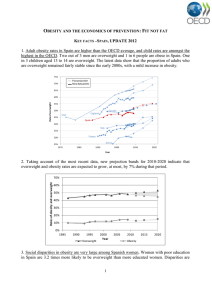
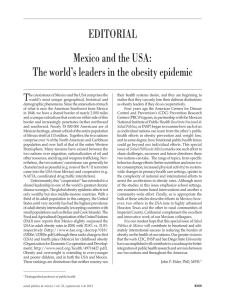
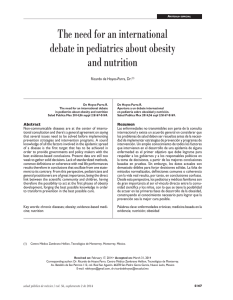
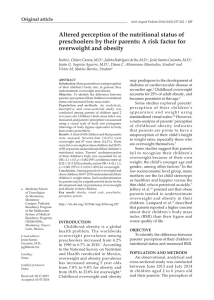
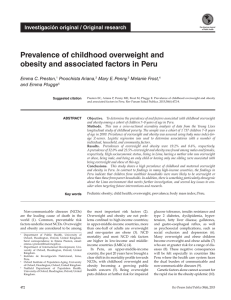
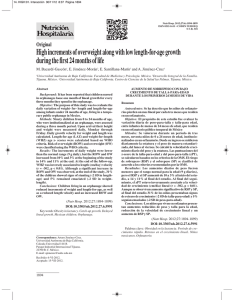
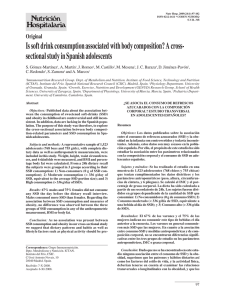
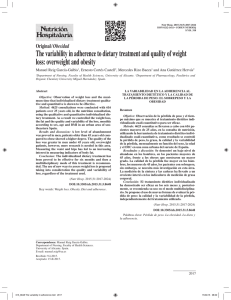
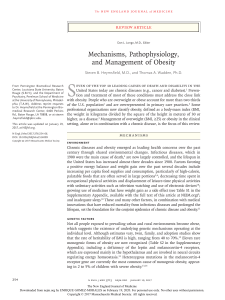
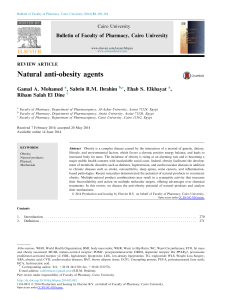
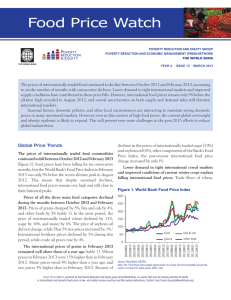
![[] Diabetes Mellitus, Obesity and Underlying Non Alcoholic Fatty Liver Disease - Independent Risk Factors for Hepatocellular Carcinoma](http://s2.studylib.es/store/data/008839203_1-639d2cfd5f7307c887258689d2f3b694-300x300.png)